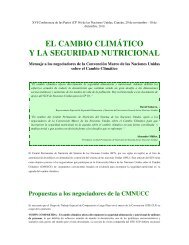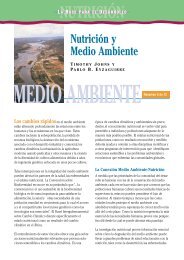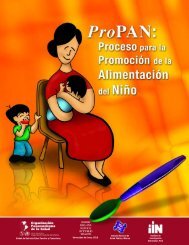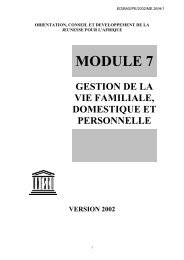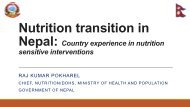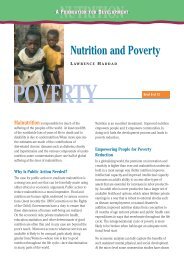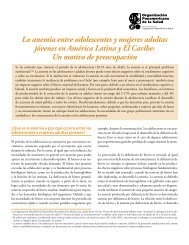SCN News No 36 - UNSCN
SCN News No 36 - UNSCN
SCN News No 36 - UNSCN
You also want an ePaper? Increase the reach of your titles
YUMPU automatically turns print PDFs into web optimized ePapers that Google loves.
www.unsystem.org/scn FEATURES 33<br />
Main directions and plans for the control of child malnutrition in Vietnam in the period 2006-2010<br />
Main strategy directions<br />
Accelerating the reduction of child malnutrition is one of the priorities within the comprehensive human development<br />
strategy of the Government of Vietnam. Reducing child malnutrition is a goal in the 10th Party Conference's<br />
document and has become an action objective of authorities and sectors at all levels. The main strategy directions,<br />
described in Khan and Khoi (2007), of the Child Malnutrition Control Program in the period 2006 to 2010 are:<br />
• The Early care strategy requires nutrition care activities for every child and mother. According to this strategy,<br />
nutrition care should be started before and during pregnancy in order to prevent foetal malnutrition.<br />
Every child should receive good care and feeding right after delivery. Special attention to nutrition care<br />
should be given during the first two years of life.<br />
• The Specific priority strategy includes specific interventions based on an analysis of the actual situation at<br />
each locality. According to this strategy, Priority should be given to interventions involving stunting reduction<br />
in difficult regions, and urgent nutrition interventions should be conducted in case of emergency. However<br />
in some regions focus will be upon prevention of overweight/obesity. Therefore, activities on malnutrition<br />
prevention for each region in the next period will not be the same.<br />
• The Nutrition improvement strategy based on the life cycle is founded on scientific evidence of a close and<br />
continuous relationship between nutritional status and its health consequences in all periods of the life cycle.<br />
It is clear that nutrition interventions should be implemented for various subjects, including pupils and<br />
adolescents. This strategy requires an application of nutrition activities for all members in a household.<br />
Implementation plans<br />
Specific implementation plans of the Child Malnutrition Control Program 2006-2010 are listed in Box 1.<br />
Evaluations, Assessments and Evolving Insights<br />
Although there have been no formal or extensive evaluations of the national PEM control strategy, limited<br />
studies of integrated nutrition programs for preschool children in Vietnam have shown that they successfully<br />
improve complementary food intake (Pachon et al 2002). In addition, they reduce both morbidity (Sripaipam<br />
et al 2002), and weight growth faltering during infancy among the most malnourished (Schoroeder et al<br />
2002). However such programs seem to do little to prevent or cure moderate undernutrition, which is more a<br />
reflection of stunting than underweight per se.<br />
It is now well recognized that the process of stunting is largely complete by two years of age in almost all populations<br />
and is caused by inadequate diet and frequent infections (Shrimpton et al 2001). Furthermore half of the<br />
stunting at two years of age is due to growth faltering in the uterus and another half to inadequate growth in the<br />
first two years of life (Victoria et al 2008). The Lancet Nutrition Series has listed a package of interventions that<br />
it considers suitable for reducing maternal and child undernutrition, which are for implementation in all <strong>36</strong> countries<br />
that are home to 90% of the worlds stunted children (Bhutta et al 2008). This includes Vietnam.<br />
Most of these interventions are included in the implementation plans listed in Box 1, but they make up less than<br />
a half of the planned activities. This suggests that it is necessary to focus and prioritize the national plan, and<br />
concentrate on those activities aimed at the window of opportunity from conception to two years of age when<br />
most growth faltering takes place. In other words, as recommended in the Lancet paper 4, "doing the right<br />
things, and doing far less of the wrong things that don't impact on maternal and child undernutrition" (Bryce et al<br />
2008). Of the list of interventions in Table 3, those aimed at reducing intra-uterine growth faltering have received<br />
the least attention in Vietnam. Moreover, it is necessary to focus on implementing the proven interventions<br />
at scale and as a continuum of care, beginning from conception though to two years of age.<br />
Preliminary review information coming from the work of the Mainstreaming Nutrition Initiative points to inadequate<br />
provincial planning capacity as a constraint for achieving high coverage of the various nutrition activities<br />
(MNI 2008). <strong>No</strong>t only is it difficult to link nutrition activities across programs within the health sector,<br />
(antenatal care, integrated management of childhood illness, primary health care) but also across sectors to<br />
the agricultural and education sectors.<br />
back to contents <strong>SCN</strong> NEWS # <strong>36</strong>





